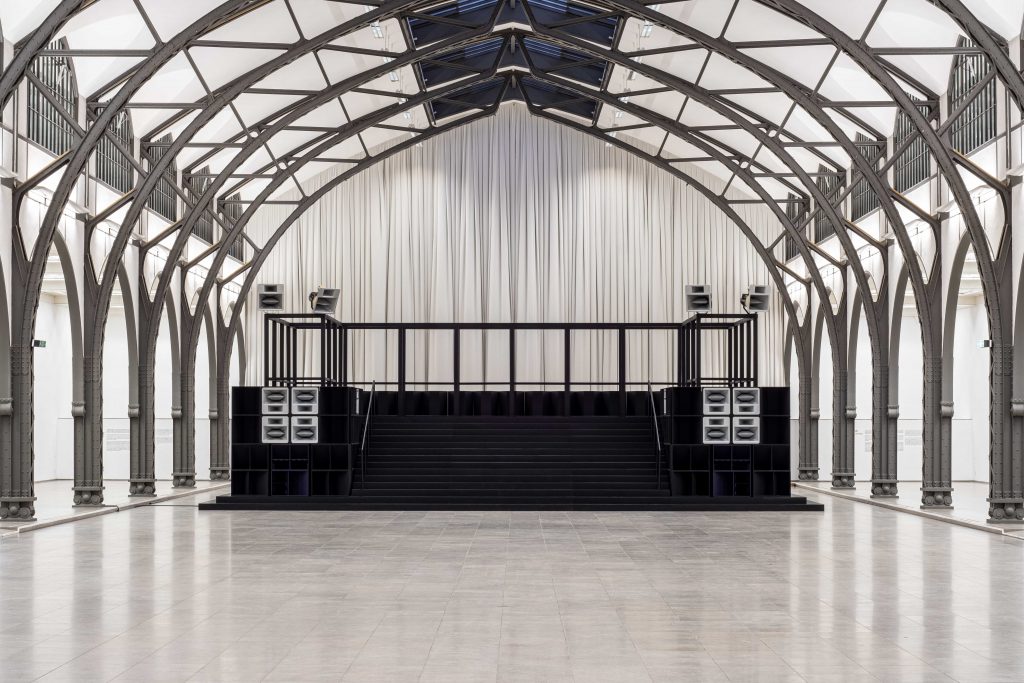Cevdet Erek
20 Years
Works of Music by Visual Artists
CEVDET EREK
Bergama Stereo
Architectural construction with sound & performance program
Hamburger Bahnhof
Museum für Gegenwart – Berlin / Historical Hall
Opening: October 18, 2019, 7 p.m.
Exhibition: October 19, 2019 – March 8, 2020
Bergama Stereo
2019
Architectural construction with 34-channel sound & performance program
Loudspeakers, amplifiers, computer, audio interface, wood, metal
4,50 m x 14 m x 9,25 m
In Bergama Stereo, an architectural installation with sound, the Istanbul-based artist and musician Cevdet Erek references the form, the historically attributed function and the ongoing reception of the Pergamon Altar, now located in Berlin, and creates a new interpretation of the famous Hellenistic edifice, which dates back to the second century BC.
Fragmentary relics of the Altar were transported from their original site in present-day western Turkey to Berlin late in the 19th century. In the newly founded German Empire, as of the 1880s, the great significance attributed to the Hellenistic site was closely linked with a flourishing appreciation of antiquity in science and culture. Beyond that, the Altar played an important role in the cultural competition between the German Empire and other great European powers, and ever since, has had a unique history as a source for other artworks and debates and as a participant in world events. A museum expressly designed for the Altar was opened in Berlin in 1901; it remains one of the city’s most popular museums. The Pergamon Museum is currently being renovated, meaning that the Altar is removed from public view for several years.
Bergama Stereois a site-specific work. It has been conceived for two locations, each individually connected with the history of the Pergamon Altar and the historical context of its reception and reconstruction. After the work was shown in the impressive industrial architecture of the Turbine Hall on the grounds of the Jahrhunderthalle (Century Hall, erected 1902) during the 2019 Ruhrtriennalein Bochum, the installation can now be experienced in the equally impressive Historic Hall of the Hamburger Bahnhof – Museum für Gegenwart – Berlin.
On the title of the work: Bergama is the Turkish name for the ancient city of Pergamon as well as the contemporary city and district in the province of Izmir. In ancient Greek, the word »stereos« originally meant »solid«. Here it stands, among other things, for the method of multi-directional and perspectival sound reproduction – an analogue to natural hearing. Typically, in audio playback and in amplification systems for live performances, stereo sound arises through the symmetrical placement of two single loudspeakers or two groups of loudspeakers. In Bergama Stereo, this audio-visual aspect is associated with the symmetric architecture of the Altar and its two wings.
Cevdet Erek conceived the dimensions of Bergama Stereofor each of the two distinctive historic halls in Bochum and Berlin. The Pergamon Altar’s proportions are slightly transformed on a reduced scale of roughly 1:2; the striking black architecture is situated at the head of the respective halls. The Altar’s famous frieze of the giants and gods, also known as the gigantomachy frieze, is interpreted through a multi-channel composition that fills the room with sound. Here, sound assumes the central role that visual elements play in the original Altar, creating a multi-dimensional narrative that relates not only to histories and the past, but also to the here and now. The sculptural frieze is replaced by a large loudspeaker frieze that projects a composition into the space via 34 separate loudspeaker channels. In analogy to the fragmentary remnants of the original Pergamon frieze and its supporting elements, which were reconstructed from archeological finds, active loudspeakers alternate with empty loudspeaker casings.
The new acoustic frieze interprets and transforms the depictions in the historic frieze in multiple ways: The battle of the Olympian Gods with the underground giants, who rebelled against their rule, is interpreted through multi-channel, spatialized sounds indicative of various present-day struggles, enabling the audience to experience them in a novel, abstract mode. It has aesthetical responses to last decades’ electronic music and club culture in Berlin as well as to specific instruments like the bass drum davul and dance rhythms of the Bergama region.
In his works, Cevdet Erek usually makes use of a reduced palette of sonic elements. These consist of percussive patterns, generated both acoustically and electronically, which occasionally arise from words and sentence fragments in different languages and from onomatopoeic elements and noises. The artist transfers these sound patterns on-site into a multi-channel composition that fills the room with rhythmic sound via a number of loudspeakers. The visitors’ movements and listening activities determine how the composition is perceived. At each place in the hall, the composition will be heard differently: When one approaches the loudspeaker frieze, individual sounds are paramount – the further away from the frieze one moves, the more the sounds overlap and merge into other rhythms. These rhythms, pulses and waves might initiate dancing movements – in this instance, acoustic experience is not limited to hearing.The composition’s structure is determined on site, during the set up of each installation. In the process, the composition changes, it becomes varied and enhanced.
In Berlin, as in Bochum, an integral component of the presentation is the concert and performance program in the exhibition hall. The program picks up on themes and structural aspects of the architecture. Musicians have been invited to relate to characteristic features of the installation such as symmetry, balance, contradiction and the content-related aspects of the work such as history, ritual, power, struggle, conflict, expulsion and migration.
The exhibition in Berlin celebrates the 20th anniversary of Works of Music by Visual Artists. The series, initiated in 1999, is an ongoing collaboration of Freunde Guter Musik Berlin e.V. with Nationalgalerie – Staatliche Museen zu Berlin. So far the series has presented concert performances of musical works and installations by Hanne Darboven, Yves Klein, Hermann Nitsch, Rodney Graham, Stephen Prina, Lawrence Weiner / Peter Gordon, Christian Marclay, Käthe Kruse, Carsten Nicolai, Janet Cardiff & George Bures Miller, Cory Arcangel, Egill Sæbjörnsson & Marcia Moraes, Ryoji Ikeda, Susan Philipsz, Saâdane Afif, Ari Benjamin Meyers, and Jorinde Voigt at Hamburger Bahnhof – Museum für Gegenwart – Berlin and at Neue Nationalgalerie.
Cevdet Erek, born 1974, lives and works in Istanbul. He studied architecture at Mimar Sinan University of Fine Arts in Istanbul (1992–1999) and sound engineering and design at the Center for Advanced Studies in Music of Istanbul Technical University, ITU (2000–2003). From 2005–2006 he was an Artist in Residence at the Rijksakademie in Amsterdam. In 2011, Erek received his doctorate in music from the Center for Advanced Studies in Music at ITU.In 2012, he received the Nam June Paik Award for Media Art from Kunststiftung NRW.He currently teaches at ITU Turkish Music State Conservatory and ITU Center for Advanced Studies in Music (MIAM).
Cevdet Erek has presented his installations internationally in numerous solo and group shows: In 2017 he represented Turkey at the Venice Biennale with his work ÇIN. In 2012, at documenta (13) in Kassel, he showed the installation Room of Rhythms, a work that he later realized in site-specific versions in altered form at MAXXI, Rome (2014), the Istanbul Biennial (2015), and the Sydney Biennale (2016). Another series of works, Sound Ornamentation, was shown at the Sharjah Biennial and the Marrakesh Biennale in 2013 and 2014. Erek was represented with large solo exhibitions at venues including Chicago Art Institute (chiçiçiçichiciçi, 2019); M HKA, Antwerp (AAAAA, 2018); MUAC, Mexico City (A Long Distance Relation, 2017); Spike Island, Bristol (Alt Üst, 2014); and Kunsthalle Basel (Week, 2012).
Publications: SSS – Shore Scene Soundtrack (Istanbul 2008, Sternberg Press, Berlin 2017), Room of Rhythms 1 (Verlag der Buchhandlung Walther König, Köln 2012), Less Empty Maybe (Revolver Publishing, Berlin 2015) and catalog ÇIN, Venice Biennale (Istanbul Foundation for Culture and Arts, 2018).
Among his sound/music work are his sound and music direction for Kaan Müjdeci’s feature length film Sivas (71st Venice Film Festival – Special Jury Prize, 2014), and music and sound co-design for Emin Alper’s feature length film Frenzy (72nd Venice Film Festival – Special Jury Prize, 2015).
Cevdet Erek is the drummer in the avantgarde rock band Nekropsi, which he co-founded and with whom he has released a series of CDs. For some time, he has also performed regularly as asolomusician on the davul, a traditional bass drum. In 2017, his first LP Davul, was released by Subtext Recordings, Berlin.
Bergama Stereo performance program:
Friday, 29 November 2019, 8 p.m.
Bergama Stereo Variations + Davul Step 2
Live Mixing: Cevdet Erek
Davul: Cevdet Erek, Gökhan Deneç, Saba Arat
Monday, 27 January 2020, 8 p.m.
Contagious [De-Constructed]
Inside piano, electronics: Andrea Neumann
Trumpet, electronics: Sabine Ercklentz
Turntables, electronics: Mieko Suzuki
Saturday, 15 February 2020, 8 p.m.
The Aesthetics of Resistance
Voices: Ayben, David Moss, Volkan T error
Saturday, 29 February 2020, 9 p.m.
DJ-Battle Nicolai Bros. vs. Lippok Bros.
Robert & Ronald Lippok, Carsten & Olaf Nicolai
4 turntables, 2 mixer, 1 dancefloor, 1 jury, 1 price
Coproduction by Freunde Guter Musik Berlin e.V., Nationalgalerie im Hamburger Bahnhof
Museum für Gegenwart – Berlin, Staatliche Museen zu Berlin, and Ruhrtriennale.
Funded by the German Federal Cultural Foundation, with support by the SAHA Association.
Curators:
Ingrid Buschmann / Freunde Guter Musik Berlin e.V.
Gabriele Knapstein / Nationalgalerie im Hamburger Bahnhof
Matthias Osterwold / Ruhrtriennale 2018 19 20
Information:
www.musikwerke-bildender-kuenstler.de
www.smb.museum/hbf
www.facebook.com/hamburgerbahnhof
www.ruhrtriennale.de
Bergama Stereo _ Flyer exhibition
Cevdet Erek_Bergama Stereo_Flyer
Bergama Stereo _ Flyer performance program
Bergama Stereo_Performance Flyer
Funded by
Supported by
Dieser Post ist auch verfügbar auf: German


